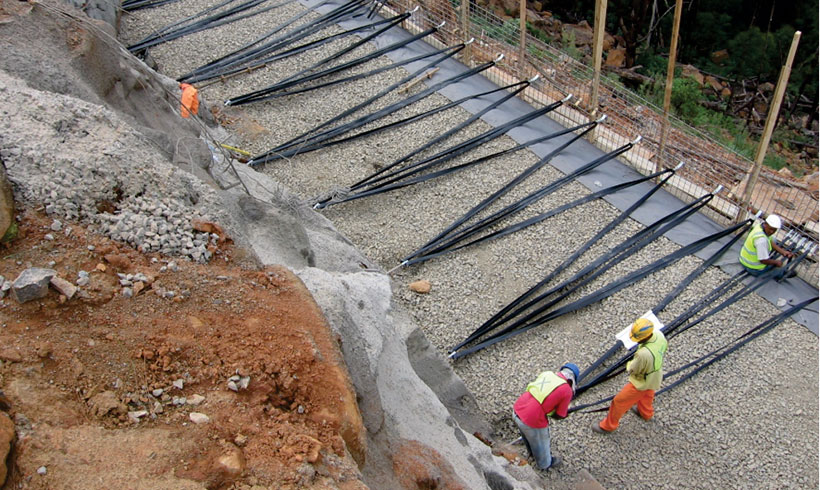Geotechnical Engineering For Construction Projects Can Be Fun For Anyone
Table of ContentsNot known Facts About Geotechnical Engineering For Construction ProjectsThe smart Trick of Geotechnical Engineering For Construction Projects That Nobody is DiscussingWhat Does Geotechnical Engineering For Construction Projects Do?The Main Principles Of Geotechnical Engineering For Construction Projects 6 Easy Facts About Geotechnical Engineering For Construction Projects ExplainedSome Of Geotechnical Engineering For Construction Projects
These features must be checked out by geotechnical engineers to forecast their activities under different scenarios., making this analysis necessary.A geotechnical engineer will examine soil to establish the bearing capacity of the earth and suggest proper foundation types, such as superficial structures, deep structures like stacks, or specialized services like floating structures for soft soils. Understanding the features and actions of soil and rock, along with exactly how they connect with building and constructions that have been set up on or within them, is among the main descriptions for why geotechnical design is necessary.
Ecological security is achieved through geotechnical engineering. Proficiency in air, water, and soil high quality maintenance is placed to utilize by geotechnical designers to lessen the adverse results of jobs.
Framework development, offshore engineering, tunnel construction, and deep foundations. Risk-based layout and multidisciplinary teams. These elements will maintain the area developing and ensure its continued value in the years to find. To summarize, geotechnical engineering is a crucial technique that preserves the durability and honesty of civil framework. Geotechnical engineers add to making structure jobs effective throughout the world by recognizing the practices of earth materials and applying appropriate preparation approaches.
The Ultimate Guide To Geotechnical Engineering For Construction Projects
By taking a look at dirt, rock, and subsurface problems, geotechnical engineers provide essential understandings that help in the design, building and construction, and upkeep of buildings and infrastructure.

Facts About Geotechnical Engineering For Construction Projects Uncovered
Research laboratory testing: Identifying the residential or commercial properties of dirt and rock. Area testing: Carrying out examinations on-site to assess problems. Evaluation and style: Utilizing information to make foundations, maintaining walls, tunnels, and various other structures. Several prominent construction projects have effectively made use of geotechnical engineering to ensure their security and safety. :: The globe's tallest building required a deep understanding of the underlying geology.

As a leader in geotechnical engineering, BECC Inc. is committed to supplying innovative and reliable options that satisfy the highest requirements of quality and safety. For more details on how BECC Inc. can sustain your following building and construction task, contact us today and allow us assist you improve solid ground.
William Rankine, an engineer and physicist, established an alternate to Coulomb's planet stress theory. Albert Atterberg developed the clay uniformity indices that are still used today for soil category. In 1885, Osborne Reynolds identified that shearing reasons volumetric extension of dense products and contraction of loosened granular materials. Modern geotechnical engineering is claimed to have begun in 1925 with the magazine of Erdbaumechanik by Karl von Terzaghi, a mechanical designer and geologist.
The Buzz on Geotechnical Engineering For Construction Projects
Terzaghi additionally created the framework for concepts of bearing capacity of foundations, and the theory for forecast of the rate of negotiation of clay layers as a result of combination. Afterwards, Maurice Biot completely established the three-dimensional soil consolidation theory, prolonging the one-dimensional design previously developed by Terzaghi to extra basic hypotheses and introducing the set of standard equations of Poroelasticity.
Geotechnical designers explore and identify the properties of subsurface conditions and products.
Indicators on Geotechnical Engineering For Construction Projects You Should Know
Geologic mapping and analysis of geomorphology are usually completed in assessment with a rock hound or engineering rock hound. Subsurface expedition generally entails in-situ screening (for example, the conventional infiltration examination and cone infiltration examination). The digging of test pits and trenching (especially for situating mistakes and slide aircrafts) may also be made use of to learn concerning dirt conditions at depth. Still, they are sometimes used to enable a rock hound or engineer to Continue be reduced right into the borehole for direct aesthetic and hand-operated examination of the dirt and rock stratigraphy. Various dirt samplers exist to satisfy the needs of different design jobs. The basic infiltration examination, which uses a thick-walled split spoon sampler, is the most common means to accumulate disrupted examples.

Typically, the interface's specific geometry is unidentified, and a simplified user interface geometry is thought. Finite slopes need three-dimensional designs to be analyzed, so most inclines are assessed assuming that they are considerably broad and can be represented by two-dimensional designs.
Geotechnical Engineering For Construction Projects for Beginners
The observational method may be called adheres to: General exploration sufficient to develop the rough nature, pattern, and residential properties of down payments. Evaluation of the most likely conditions and the most undesirable conceivable deviations. Producing the design based on a functioning hypothesis of behavior expected under the most probable conditions. Choice of amounts to be observed as building and construction proceeds and have a peek at this site computing their prepared for values based upon the working theory under the most unfavorable conditions.
Dimension of amounts and analysis of real problems. Layout alteration per real problems The empirical technique appropriates for construction that has already started when an unexpected advancement happens or when a failing or crash looms or has currently occurred. It disagrees for projects whose design can not be altered throughout building.